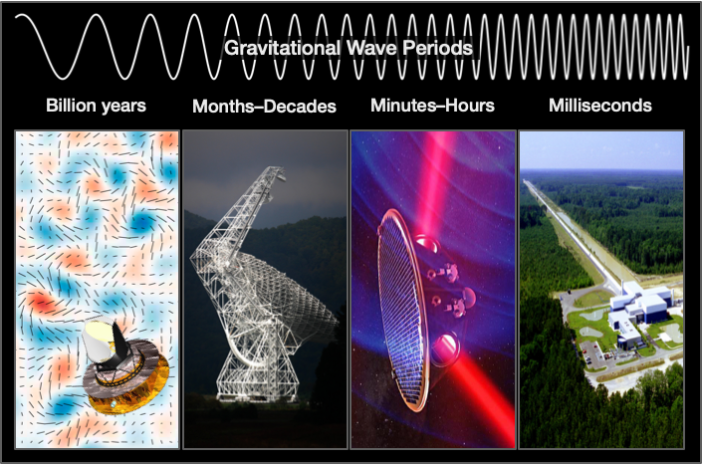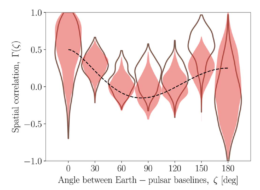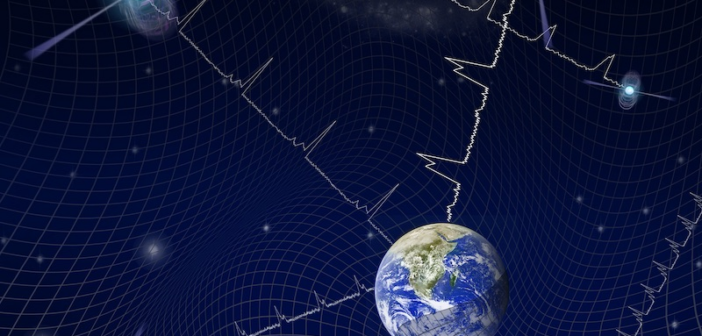Deep within the universe, supermassive black holes are swirling around each other, giving off an immense amount of energy that travels at the speed of light through a fabric of ticking stellar clocks. Have we been looking long enough to catch their distant background whisper?
In 2015, LIGO announced the first detection of ripples in the fabric of spacetime, and since then, scientists have detected ~90 gravitational-wave events (35 of which were announced this week!), consisting of black hole–black hole mergers, neutron star–neutron star mergers, and black hole–neutron star mergers. These different sources each produce their own frequency of gravitational waves depending on the mass of the object. For instance, binary neutron star mergers are very energetic and happen quickly, so they produce high-frequency waves, but mergers of supermassive black hole binaries happen much more slowly and generate much weaker, low-frequency waves. Much like how you can’t detect a gamma-ray burst with an infrared telescope, you can’t observe gravitational waves from binary supermassive black holes with something meant for binary neutron star mergers. This is where pulsar timing arrays come in.
A Galaxy-Sized Gravitational Wave Detector

Different frequencies of gravitational waves that can be detected by various instruments that can detect them (left to right: BICEP2, the Green Bank Telescope LISA, LIGO). [Shami Chatterjee/NANOGrav]
When searching for gravitational waves, the goal is not only to detect them but also to characterize them. The passage of a gravitational wave changes the arrival times of pulsar signals in a distinctive way that can be described by something known as the Hellings–Downs curve. By obtaining many times of arrival from pulsars all around the sky, astronomers can look for signs of this curve and use it to characterize the source of the gravitational waves.

The Hellings–Downs Curve, which plots the separation between pulsars against the correlation between their arrival times. If a gravitational wave passes through, it will show up in the times of arrival between different pairs of pulsars on the sky and follow this curve exactly. [Mike Zevin/Astrobites]
Hunting for the Hellings–Downs
But this is easier said than done! The gravitational waves that can be detected by timing arrays are incredibly weak, so an immense amount of data is needed to identify these elusive signals — and pulsar timing efforts around the world have been searching for decades without any luck. Recently, however, the North American Nanohertz Observatory for Gravitational Waves (NANOGrav) collaboration found a signal in their data that could be a sign of lurking gravitational waves.
While NANOGrav’s detection may be the long-awaited signal from these background gravitational waves, we can’t rule out the possibility that this is noise in the data, such as dust in the interstellar medium or certain phenomena in pulsars that change the spin period slightly, such as glitching. To confirm NANOGrav’s results, we ideally need independent observations of the Hellings–Downs curve from another group.

The angle between the pulsars against the correlation between times of arrival the team measured. The dotted line is the predicted correlation, the solid lines are the distributions, and the red is the error in those measurements. Their measurements could indicate a Hellings–Downs curve but their errors show that this may not be the case. [Goncharov et al. 2021]
An International Pursuit
International efforts are currently underway to combine data from telescopes around the world to combine data from telescopes around the world to create one big data set to search through for gravitational waves. With hints of some kind of signal in NANOGrav data, Parkes Pulsar Timing Array data, and, most recently, European Pulsar Timing Array data, we may not be far from hearing the whisper of supermassive black hole binaries.
Citation
“On the Evidence for a Common-spectrum Process in the Search for the Nanohertz Gravitational-wave Background with the Parkes Pulsar Timing Array,” Goncharov et al 2021 ApJL. 917 2. doi:10.3847/2041-8213/ac17f4

